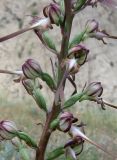
Часть соцветия. Крым, окр. Феодосии, Лисья бухта. 15 июня 2011 г.
Alexander Fateryga CC BY-NC 2011
The marker on the map does not indicate the exact coordinates of the plant or lichen.
The marker does only indicate the conditional center of the terrain ("geographic point") where the photo was taken.
Open mapSee also:
Discussion (11)
All photos of taxon (127)
Code of link to photo
| Create: | HTML or BBCode with preview |
| Code for linking on the web: | |
| This is how it will look: |  Himantoglossum caprinum on the site «Plantarium» |
Text to cite the page
Фатерыга А. 2011. Изображение Himantoglossum caprinum (M. Bieb.) Spreng. // Плантариум. Растения и лишайники России и сопредельных стран: открытый онлайн атлас и определитель растений. [Электронный ресурс] URL: https://www.plantarium.ru/page/image/id/112501.html (дата обращения: 23.12.2025).
Fateryga A. 2011. Image of Himantoglossum caprinum (M. Bieb.) Spreng. // Plantarium. Plants and lichens of Russia and neighboring countries: open online galleries and plant identification guide. URL: https://www.plantarium.ru/lang/en/page/image/id/112501.html (accessed on 23 Dec 2025).
Views: 2807Discussion
| Станислав Глоц | In my opinion it is not Himantoglossum caprinum but Himantoglossum affine. H. affine has no dots on the lip. I know these plants from eastern Turkey. From my point of view all the plants from Crimea and Novorossijsk region are H. affine. The only H. caprinum on this page is the plant from Greece. I know these plants from Slovakia, Serbia, Montenegro and western Turkey. These plants have dots on the lip. |
| Andriy Kovalchuk | Dear Stanislav,
it's indeed, an interesting issue. I noticed it when Roland first placed his pictures, and the corresponding discussion can be found under the following link:
http://forum.plantarium.ru/viewtopic.php?id=17919
It looks like plants from Crimea are quite distinct from the ones from the South-Eastern Europe, to which the name H. caprinum is usually applied in European literature. However, the name H. caprinum is based on Orchis caprina Bieb., described by Marschall Bieberstein on material collected in Crimea:
http://www.biodiversitylibrary.org/item/42075#page/608/mode/1up
Unfortunately, the original description doesn't mention the presence or absence of dots on the lip, and I have read somewhere that the type specimen of O. caprina is not well preserved. However, all the material from Crimea seems to be quite uniform, and it looks to me that if the plants from Crimea and South-Eastern Europe are specifically distinct, then the name H. caprinum should belong to the first ones. |
| Станислав Глоц | Interesting situation! For (all?) western botanists the situation is clear: the plants from South-Eastern Europe and Western Turkey belong to Himantoglossum caprinum (not H. hircinum or H. adriaticum) and they have dots on the lip and plants from Eastern Turkey are H.affine - they don´t have dots on the lip. From this point of view the Crimean plants should belong to H. affine. See e.g. http://www.guenther-blaich.de/artseite.php?par=Himantoglossum caprinum&abs=artlst&xx=artlstArt104-V---1IH0 and http://www.guenther-blaich.de/artseite.php?par=Himantoglossum affine&abs=artlst&idx=216&xx=artseite549. But if the H. caprinum was for the first time described from Crimea then the taxonomy should be overworked.
P.S. You can answer Russian, I can Russian pretty well but writing is for me difficult. |
| Vasyl Heluta | Очень интересная дискуссия. Я посмотрел все фото в моей базе, снятые в Крыму разными фотографами, - на всех губа без пятнышек. Если Himantoglossum caprinum действительно описан из Крыма, значит западным ботаникам придётся менять свою точку зрения. |
| Andriy Kovalchuk | Yes, that's something that definitely should be investigated more thoroughly. At least, Sprengel also mentioned the locality 'Tauria' when he published his combination 'Himantoglossum caprinum':
http://biodiversitylibrary.org/item/15254#page/695/mode/1up |
| Станислав Глоц | One more notice: according Kew Garden Checklist both H. caprinum and H. affine should occur in Crimea, see:
http://apps.kew.org/wcsp/namedetail.do;jsessionid=63366DE62622C60A68CCFA8D8A37E59D?name_id=99264
http://apps.kew.org/wcsp/namedetail.do;jsessionid=1F0F17B89A1598B58DC119633463890E?name_id=99268 |
| Andriy Kovalchuk | I think that for the definitive answer one should check the type specimen of Orchis caprina Bieb. |
| Станислав Глоц | Андрей Ковальчук wrote:
Yes, also it is necessary to answer the question whether both the plants with dots and the plants without dots on the lip grow in Crimea.I think that for the definitive answer one should check the type specimen of Orchis caprina Bieb. |
| Alexander Fateryga | Уважаемые коллеги! О том, что в Крыму растет H. affine известно с 2008 года - http://www.bgbm.org/willdenowia/w-pdf/wi38-2Greuter Raus.pdf, есть еще новая статья - Sramko, Molnar 2012 Phylogenetics of the Eurasiatic genus Himantoglossum (15TH EUROPEAN ORCHID CONGRESS AND SHOW), там тоже в Крыму упоминается H. affine.
На фото из Греции другой вид. Сколько видов в Крыму - одни считают, что один, другие - что два.
Я не стал поднимать эту тему, так как группой исследователей (тот же Sramko и другие люди) уже всё сделано - просмотрены типы, растения из типовой местности и так далее, и очень скоро должна выйти их статья, которую я с нетерпением жду, чтобы узнать результаты их работы. |
| Alexander Fateryga | Вышла статья на эту тему, но у меня открывается только первая страница, скачать всю получится к концу недели, или кто-нибудь пришлет к тому времени.
Со слов А.В. Ены - H. affine сведен в синонимы к H. caprinum (H. caprinum - старшее название), а что касается второго вида (на фото из Греции), то как его называть не понятно, возможно полный текст статьи прояснит ситуацию, во всяком случае, это теперь не H. caprinum, поэтому возьму на себя смелость перенести к роду. |
| Andriy Kovalchuk | Ремнелепестники с пятнистой губой пока никак не назвали - в статье лишь написано, что новое название будет обнародовано в следующей публикации. |